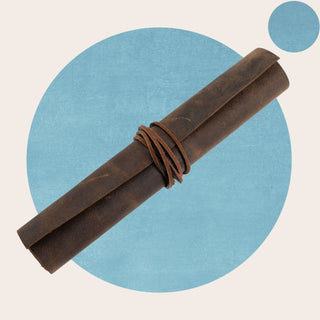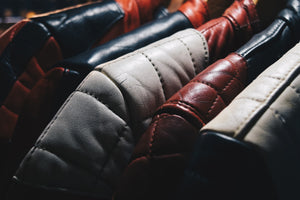Is your leather looking tired and old? Are you scared even to wear it out lest you be pelted with rotting fruit like some medieval object of disdain? Want to learn how to make leather look new again?
Then you are in the right place, for today we will be exploring 3 top methods for restoring the natural luster of your leather back.
Method 1: Preparing the Leather
Are you keen to learn how to restore the former luster of your leather goods? Then step right up for a literate guide to leather care.
- Clean the leather before using a leather conditioner to ensure you do not lock in any dirt or grime already on the surface. Mix a dishwashing soap and warm water (1 part soap to 8 parts water) or use saddle soap to clean the leather before moisturizing.
- Lather the surface by dipping a soft lint-free cloth into the solution before wringing the cloth out lightly and wiping down the damaged surface. This should be a damp cloth, though not too damp. Too much moisture at this stage could distress faux leather. To remove deeper stains on, say, a worn leather bag or leather portfolio, use rubbing alcohol instead.
- Rinse the cloth thoroughly and dip it into cool, clean water before wringing it out lightly and running it over the leather surface again. If this is, say, a piece of leather furniture like a leather sofa, you will want to ensure that all soap is removed from the leather, lest it does some serious damage later down the line.
- Once the excess soap has been removed from the surface of the leather, the only thing to do is to wait while the leather dries naturally. Avoid using a heater, blow dryer, or another kind of heat source for the job, no matter how quickly it may modify the drying time. Heat can actually change the chemical structure of leather, stiffening it into a shape that is otherwise not it's own. For the best results, let the leather object dry naturally with the air of its own accord.
Method 2: Fixing the Surface
Perhaps there are some serious imperfections to the surface of the leather? Do not fear, for help is at hand!
- Buy a leather repair kit. These are usually available from most hardware stores or, alternatively, can be purchased online. Read user reviews beforehand to buy the best kit.
- To avoid any stains from the ingredients, lay down some old newspapers, plastic sheeting, or towels beneath the leather object. Also, try to wear protective gloves and old clothing that you do not mind staining while doing the repair. In addition, you are best advised to open the windows or do the work outside to avoid the fumes.
- Apply the leather repair compound to the grain leather using a sponge, gently spreading it in a thin layer over the entire surface of the part that is too worn to ignore. Repeat this process between 3 and 5 times or until you are satisfied with the results.
- Now, add a thin coat of colorant - essentially leather dye. Only add a small amount to the faded leather at first, and ensure that you are doing so with a soft cloth and a dry cloth. Apply a thin coat to the leather, especially concentrating on hard-to-reach areas like cracks, creases, and seams.
- Once you have established this first layer, spray on some more - perhaps even fill a spray gun with some. Spray the coats very fine to avoid runs or oversaturation. Allow the surface to dry and repeat until the surface looks adequately covered (water-based colorants should dry within a few minutes).
- Finally, once the leather is dry, use a soft cloth free of lint to apply a leather conditioner to the surface, ensuring that you do so evenly and over the entire surface. For bonus points, gently buff the leather to make it supple and shiny.
Can leather be painted? Kind of, yes.

Method 3: Repairing a Small Scratch
Did you take your distress-leather ideology a bit far? Has your leather jacket soaked up your trauma? Then help is at hand. Put the nail polish remover away first, though.
First of all, try treating the scratch with some vinegar, applying a small amount of distilled white vinegar to the scratch with a Q-tip or a small cloth. Once the vinegar has swelled the scratched area, let it dry, and then gently buff the area with colorless shoe polish.
Next, try rubbing the scratch with oil - orange oil and/or olive oil should do the trick. Using a damp cloth, rub the oil into the scratch and surrounding area with buffing motions, thereby conditioning the leather while healing it. However healing it might be in small doses, use the oil sparingly, as it can sometimes do more harm than good.
Likewise good for leather in small doses is heat. Thus, use a blowdryer sparingly to dry the oil, setting it to a medium setting and directing it at the section of scratched leather while gently rubbing the scratch with a free hand. This heat is supposed to bring the dyes applied to the leather at the tannery back to the surface, reducing the appearance of the scratch considerably.
To future-proof your leather from future scratches like this, try treating the leather with a weather-resistant protection spray, making sure to reapply it every three months (or whenever the packaging says). Keep your leather away from water as much as possible, ensuring that you are as delicate as possible with it when you are drying it, avoiding direct heat, and, instead, air-drying as often as possible. Also, try using a leather conditioner to moisturize the leather every few months, or whenever the leather starts to feel dry.

Final Words
So, there you have it! Hopefully, you are now feeling ready and able to restore that natural luster back to your leather item, no matter what that item might be.
FAQs How to Make Leather Look New
CAN WORN-OUT LEATHER BE RESTORED?
Indeed it can, depending on the severity of the damage of course. Very often, when leather seems incredibly worn out, the most it needs is a bit of love and attention. This typically comes in the form of using a leather conditioner to restore its previous luster. Applying the conditioner to the surface of the leather and buffing it in whenever it begins to look dry is a sure way to restore your leather item.
HOW DO I BRING MY LEATHER BACK TO LIFE?
This depends on what exactly the issue with the leather is. Often, it is just a case of applying some leather conditioner to bring out the natural dyes that were imbibed into the leather during the tanning process. However, in some instances, the leather might be cut up and damaged, in which case a slightly different approach will need to be taken. In these instances, you can use vinegar, orange oil, and/or olive oil to bring the dyes in the leather back to the surface, thereby obscuring the scratch.
HOW DO YOU RESTORE LEATHER NATURALLY?
There are plenty of methods for restoring leather naturally, though what you will need will depend on the condition of the leather. The issue is usually a case of conditioning the leather a little when it is chapped, though in some instances you might need to do a little more repairing, using orange oil or olive oil to bring out the dyes from the tanning process to obscure scratches on the surface of the leather.



